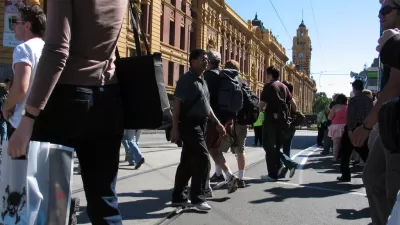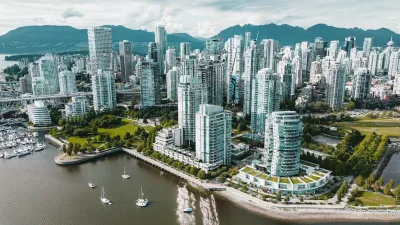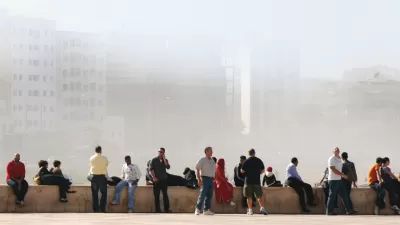Danish architect Jan Gehl and a steadfast group of local collaborators have transformed Melbourne from a lifeless 9-5 city into a preeminently livable place. Mitra Anderson-Oliver looks at the principles that have guided their work.

"Working with the City of Melbourne in 1993 (Gehl was invited by the council to conduct a Public Spaces and Public Life survey – and again for a 2004 update [PDF]), a key recommendation was to create opportunities for outdoor dining, mimicking the success of the grand boulevards of Paris and the communal squares of Rome," notes Anderson-Oliver. "The suggestion was ridiculed in a city famous for its icy southerlies and four-seasons-in-one-day climate. Yet, twenty years later, Melbourne boasts the highest ratio of street furniture per person in the world; outdoor cafes have increased from less than 50 in 1990 to over 600 today; the number of pedestrians in the city on weekday evenings has doubled; and Swanston Street has more pedestrians per day than Regent Street in London."
"Forty years of this close observation of human behavior (rather than a more theoretical engagement with urban studies: 'I am not much into reading', he confesses) lies behind Gehl’s core beliefs of treating pedestrians and cyclists 'sweetly' and the need for the city to be an 'invitation' to spend time, a welcoming and sustaining place for people to live. 'A good city is like a good party', he says. 'You know it’s working when people stay for much longer than really necessary, because they are enjoying themselves.'"
FULL STORY: CITIES FOR PEOPLE: JAN GEHL

Planetizen Federal Action Tracker
A weekly monitor of how Trump’s orders and actions are impacting planners and planning in America.

Maui's Vacation Rental Debate Turns Ugly
Verbal attacks, misinformation campaigns and fistfights plague a high-stakes debate to convert thousands of vacation rentals into long-term housing.

San Francisco Suspends Traffic Calming Amidst Record Deaths
Citing “a challenging fiscal landscape,” the city will cease the program on the heels of 42 traffic deaths, including 24 pedestrians.

Defunct Pittsburgh Power Plant to Become Residential Tower
A decommissioned steam heat plant will be redeveloped into almost 100 affordable housing units.

Trump Prompts Restructuring of Transportation Research Board in “Unprecedented Overreach”
The TRB has eliminated more than half of its committees including those focused on climate, equity, and cities.

Amtrak Rolls Out New Orleans to Alabama “Mardi Gras” Train
The new service will operate morning and evening departures between Mobile and New Orleans.
Urban Design for Planners 1: Software Tools
This six-course series explores essential urban design concepts using open source software and equips planners with the tools they need to participate fully in the urban design process.
Planning for Universal Design
Learn the tools for implementing Universal Design in planning regulations.
Heyer Gruel & Associates PA
JM Goldson LLC
Custer County Colorado
City of Camden Redevelopment Agency
City of Astoria
Transportation Research & Education Center (TREC) at Portland State University
Jefferson Parish Government
Camden Redevelopment Agency
City of Claremont





























